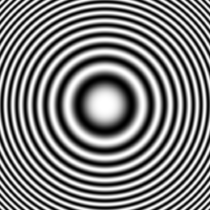

A zone plate is a device used to focus light or other things exhibiting wave character.[1] Unlike lenses or curved mirrors, zone plates use diffraction instead of refraction or reflection. Based on analysis by French physicist Augustin-Jean Fresnel, they are sometimes called Fresnel zone plates in his honor. The zone plate's focusing ability is an extension of the Arago spot phenomenon caused by diffraction from an opaque disc.[2]
A zone plate consists of a set of concentric rings, known as Fresnel zones, which alternate between being opaque and transparent. Light hitting the zone plate will diffract around the opaque zones. The zones can be spaced so that the diffracted light constructively interferes at the desired focus, creating an image there.
- ^ G. W. Webb, I. V. Minin and O. V. Minin, “Variable Reference Phase in Diffractive Antennas”, IEEE Antennas and Propagation Magazine, vol. 53, no. 2, April. 2011, pp. 77-94.
- ^ Wood, Robert Williams (1911), Physical Optics, New York: The MacMillan Company, pp. 37–39